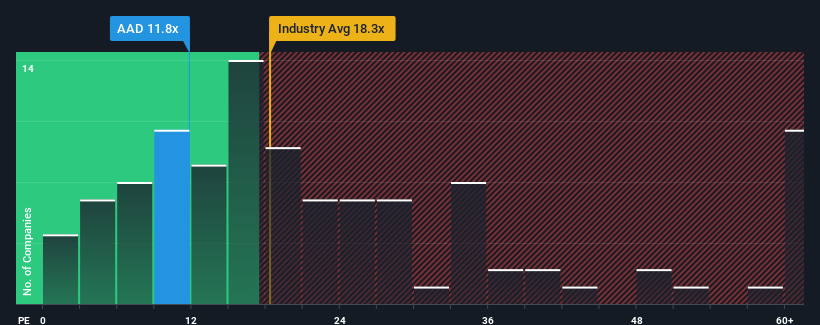- Germany
- /
- Professional Services
- /
- XTRA:AAD
Amadeus FiRe AG's (ETR:AAD) Earnings Are Not Doing Enough For Some Investors

With a price-to-earnings (or "P/E") ratio of 11.8x Amadeus FiRe AG (ETR:AAD) may be sending bullish signals at the moment, given that almost half of all companies in Germany have P/E ratios greater than 16x and even P/E's higher than 29x are not unusual. Although, it's not wise to just take the P/E at face value as there may be an explanation why it's limited.
Amadeus FiRe hasn't been tracking well recently as its declining earnings compare poorly to other companies, which have seen some growth on average. It seems that many are expecting the dour earnings performance to persist, which has repressed the P/E. If you still like the company, you'd be hoping this isn't the case so that you could potentially pick up some stock while it's out of favour.
View our latest analysis for Amadeus FiRe

Does Growth Match The Low P/E?
In order to justify its P/E ratio, Amadeus FiRe would need to produce sluggish growth that's trailing the market.
Taking a look back first, the company's earnings per share growth last year wasn't something to get excited about as it posted a disappointing decline of 16%. This has soured the latest three-year period, which nevertheless managed to deliver a decent 9.4% overall rise in EPS. So we can start by confirming that the company has generally done a good job of growing earnings over that time, even though it had some hiccups along the way.
Turning to the outlook, the next year should generate growth of 5.8% as estimated by the two analysts watching the company. With the market predicted to deliver 22% growth , the company is positioned for a weaker earnings result.
With this information, we can see why Amadeus FiRe is trading at a P/E lower than the market. It seems most investors are expecting to see limited future growth and are only willing to pay a reduced amount for the stock.
What We Can Learn From Amadeus FiRe's P/E?
Using the price-to-earnings ratio alone to determine if you should sell your stock isn't sensible, however it can be a practical guide to the company's future prospects.
We've established that Amadeus FiRe maintains its low P/E on the weakness of its forecast growth being lower than the wider market, as expected. At this stage investors feel the potential for an improvement in earnings isn't great enough to justify a higher P/E ratio. Unless these conditions improve, they will continue to form a barrier for the share price around these levels.
Don't forget that there may be other risks. For instance, we've identified 1 warning sign for Amadeus FiRe that you should be aware of.
Of course, you might also be able to find a better stock than Amadeus FiRe. So you may wish to see this free collection of other companies that have reasonable P/E ratios and have grown earnings strongly.
New: Manage All Your Stock Portfolios in One Place
We've created the ultimate portfolio companion for stock investors, and it's free.
• Connect an unlimited number of Portfolios and see your total in one currency
• Be alerted to new Warning Signs or Risks via email or mobile
• Track the Fair Value of your stocks
Have feedback on this article? Concerned about the content? Get in touch with us directly. Alternatively, email editorial-team (at) simplywallst.com.
This article by Simply Wall St is general in nature. We provide commentary based on historical data and analyst forecasts only using an unbiased methodology and our articles are not intended to be financial advice. It does not constitute a recommendation to buy or sell any stock, and does not take account of your objectives, or your financial situation. We aim to bring you long-term focused analysis driven by fundamental data. Note that our analysis may not factor in the latest price-sensitive company announcements or qualitative material. Simply Wall St has no position in any stocks mentioned.
About XTRA:AAD
Established dividend payer and fair value.
Similar Companies
Market Insights
Community Narratives




